Chemical Milling Environmental Improvements, Aerospace is Green and Growing
By David Tomlinson and James Wichmann, AC Products Inc.
#aerospace #sustainability
By David Tomlinson and James Wichmann, AC Products Inc.
Editor's Note: A printable PDF version of this paper is available by clicking HERE.
Featured Content
ABSTRACT
In the aerospace industry, chemical milling is the process of using a strong acid or base solution (etchant) to dissolve unwanted aluminum, titanium, steel, etc., during the manufacture of aircraft parts. The primary purpose of the chemical milling process is to reduce the weight of fuselage skins and other parts, to improve the efficiency of aircraft. The process involves coating the entire part with a unique maskant film, and then removing (peeling away) select areas to allow the etchant solution to dissolve (chemically mill) the unwanted portions from the sheet stock. The process has been used on a variety of metals with removal depths in excess of 10 mm (0.4 inch). The maskant film is also effective in protecting select areas of parts during various anodizing and plating processes, including chromic acid anodizing, phosphoric acid anodizing and metal plating. The maskant film can be applied by either spray or by immersion, and offers several options to comply with current and future VOC regulations. This paper discusses several technologies designed to reduce emissions to the atmosphere and to reduce overall costs to the chemical milling process. At the end of this paper is a photographic portfolio of the process, including masking.
Keywords: chemical milling, aluminum, titanium, steel, aerospace, environmentally friendly processing.
Chemical Milling Maskants
Chemical milling has been an important aerospace process since the late 1950s. Early operations were not environmentally friendly. Chemical milling maskants emitted solvent directly to the atmosphere and large volumes of dissolved aluminum (etchants) required frequent dumping, which also resulted in significant loss of production process time. AC Products is a global supplier of chemical milling maskants and has been a part of the many technical and process changes that improve the health and environmental impact of the chemical milling process.
Solvent-based maskants
Conventional solvent-based maskants are highly refined and robust organic coatings which are designed to meet the industry’s very specific needs. The necessary performance criteria require that the maskant must be chemically resistant from the milling etchant. It must be able to be selectively and easily removed both before and after the milling process. Finally, it must provide good dimensional characteristics to the part (line definition, undercut ratio, etc.).
The initial formulas for solvent based maskants contained natural rubber polymers and pigments and were typically solvated with toluene and xylene. The industry, during the 1950s through to the 1970s, directly vented these solvents to the atmosphere. The solids portion of the maskant provides the film properties necessary for the chemical milling process. The application of solvent based maskants can be done by spray, brush or direct immersion. The spray process typically employs airless spray equipment. It can also employ high-volume, low-pressure (HVLP) and conventional siphon spray equipment. The direct immersion method is also used and is well suited for automation and has the potential of 100% transfer efficiency.
By the early 1970s, synthetic rubbers were firmly established into the maskant composition. These rubbers are the basis for the high performance and the robust properties that the industry enjoys today. These maskants provide robust performance through other acid anodizing, structural bonding and physical protection during routing and drilling.
The solvent of choice for these maskants is perchloroethylene. Perchloroethylene is non-flammable and it can be easily recovered and later reused when employed in conjunction with the carbon adsorption process. Later in this paper, the carbon adsorption process will be discussed.
Two other methods used to meet health and environmental regulations are incineration (thermal oxidation) and the use of an exempt solvent. Both of these methods enable the continued use of the high performance synthetic polymers developed into the solvent based maskants described above. In the case of incineration, the maskant is solvated in toluene or a blend of toluene/xylene. During the maskant application and drying process, the toluene laden air is either burned directly through an incinerator or accumulated in a carbon bed and burned later. In the case of using an exempt solvent, the exempt solvent is vented directly to the atmosphere. The exempt solvent can also be recovered and reused using the carbon adsorption method. It’s The chemical name for the exempt solvent is parachlorobenzotriflouride (trade name Oxsol 100, IsleChem).
Water-based maskants
Water-based chemical milling maskants also meet health and environmental regulations. Water-based maskants use latex technology, which suspends the rubber polymers and pigments in a water environment. The water-based maskants were developed in the 1980s and their use and performance improved significantly during the 1990s. Water-based chemical milling maskants are similar to solvent based maskants in that they both contain pigments to aid performance and have a simple lacquer dry, with no chemical reaction during the dry/bake cycle.
Polyurethane-urea based chemistry
Maskants using polyurethane/urea chemistry is another maskant technology that can be used to meet health and environmental regulations. Urethane chemistry employs two components, isocyanates and polyols. Urea chemistry employs isocyanates and amines. Each of the two components is liquid when alone, but when mixed together at designed ratios, they form a solid film when applied using plural component spray equipment. When no solvent is contained in either of the components, the mixture can achieve 100% solids. The technology is limited to spray application as the two components have a very short pot life which requires the ratio mix to occur immediately prior to application. The pot life can range from a few seconds to several minutes.
Line sealers
Line sealers are coatings used after hand or laser scribing to seal these scribed areas against leakage from the etchant for multiple step cuts during chemical milling. Newer water-based technology has eliminated the need for solvent-based line sealers. In addition, the use of water-based line sealers has greatly improved application speed of the process and reduced the overall defect rate on chemical milled parts due to scribe line leakage or other undetected defects.
Solvent Recovery and Carbon Adsorption
The most effective method used to reduce the emission of solvent vapors is by capturing and recycling them through a carbon adsorption system. Using this method, the maskant application and dry areas are isolated in a fixed and sealed structure that contains the solvents.
A properly designed and sized carbon adsorption system can return 98% or more of the captured solvent vapors for reuse. The carbon adsorption process scrubs clean the solvent contained in the structure surrounding the maskant application and dry area. It does this by extracting the solvent-laden air through a bed of activated carbon. The solvent is adsorbed onto the surface of the carbon granules and the purified air is exhausted to atmosphere. Depending upon the operating conditions and the solvent involved, activated carbon can adsorb 5-30% of its weight in organic solvent. The adsorption cycle can continue until the entire carbon bed is saturated with solvent, at which point solvent would begin to be exhausted with the air. In actual operation, the adsorption cycle is stopped before the bed is fully saturated. Two methods of stopping are available, timers and vapor monitors. With timers, the adsorption cycle is stopped after a preset period of operation. With vapor monitors, the adsorption cycle is stopped when solvent monitors detect a predetermined concentration of solvent in the exhaust stream.
At the end of the adsorption cycle, the unit switches to the desorption cycle. The solvent laden air stream is closed via dampers, and steam is admitted into the carbon bed (Portfolio Fig. 5) to vaporize the adsorbed solvent. The mixture of steam and solvent vapor pass through a condenser and separate into two liquid layers. Water at 8.33 lb./gal density is collected from the top layer, perchloroethylene at 12.95 lb./gal density is collected from the bottom layer. The recovered solvent is easily removed from the lower level and is immediately available for reuse into new liquid maskant. After the steam purge, the carbon bed is purged with hot air to dry and then cooled with ambient air in preparation for the next adsorption cycle. Normally, two or more carbon beds are used in parallel such that one is immediately available to collect solvent from the solvent-laden air stream. This assures compliance with regulatory standards as well as maximum solvent recovery.
Etchant Recovery
Aluminum regeneration is another stride made to improve the process environmental impact. Aluminum regeneration was developed in the 1970s and its use today is effectively 100%. It takes place in two forms.
In the first form, the chemical milling facility purchases sodium hydroxide and incorporates it into an etchant. Via the chemical milling process, the etchant is eventually saturated with dissolved aluminum (aluminum oxide) and a recharge of the etchant tank is necessary. At this point, all or a portion of the etchant is removed from the process tank and transported to an aluminum supplier where the dissolved aluminum is used as a feed to manufacture additional aluminum. The full life cycle recovery of the aluminum is between the aluminum supplier and the chemical milling facility.
In the second form, the chemical milling facility can incorporate an etchant recovery unit. An etchant recovery unit can provide a full life cycle recovery for the aluminum and for the sodium hydroxide. An etchant recovery unit provides the aluminum oxide in a more pure form, and reverses the sodium hydroxide reaction with aluminum.
Etching reaction: (1)
Hydrolysis reaction: (2)
Maskants are designed for and are regularly used for a wide variety of chemical processes in addition to chemical milling. In aerospace, they are formulated for processing through the full range of surface treatments including cleaning and anodizing processes previously mentioned. In addition, they can be utilized for aluminum anodizing Types 1, 2, & 3, cadmium plating Type 1 & 2, nickel plating, both electroless and ductile, and may also be used for hard chromium plating. Maskants also provide physical protection during general shop operations such as routing, forming and metal bonding.
Conclusion
In the past, chemical milling operations have not had a good reputation regarding environmental issues. Maskant application emitted large volumes of solvent directly to the atmosphere, etchant tanks required frequent dumping due to saturation of sodium aluminate, sodium hydroxide was not recycled and large volumes of water were polluted and discarded.
Today, several new technologies have emerged regarding chemical milling maskants. Solvent collection has been developed and enables recovery rates in excess of 95% and is available for recycle. Sodium hydroxide and aluminum can also be recycled which enables improved process efficiency and reduced costs. There is always room for further improvement, but considerable progress has been achieved.
A Photographic Portfolio of the Chemical Milling Process
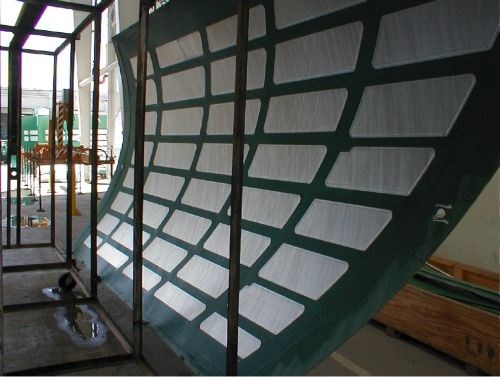
Figure 1 - Sheet aluminum stock is stretched formed and coated with maskant. Select areas of maskant have been removed and the part is ready for the chemical milling process.
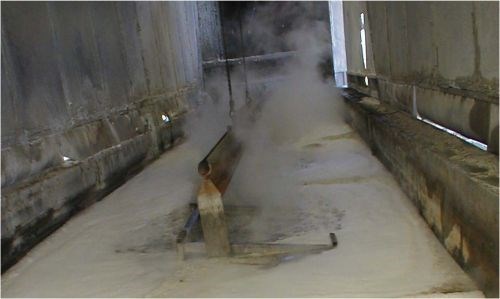
Figure 2 - The part is submerged into the chemical milling etchant.
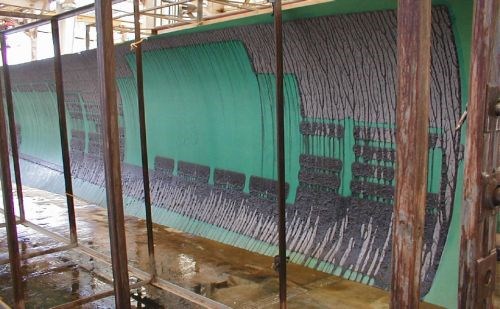
Figure 3 - Appearance immediately after the chemical milling process.
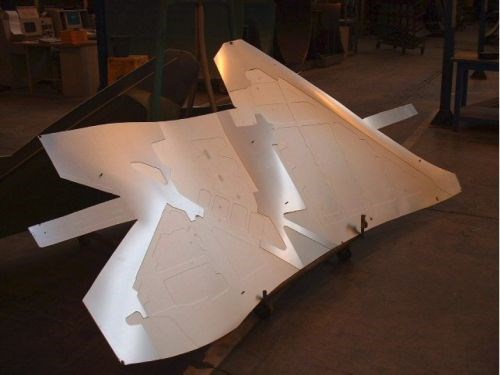
Figure 4a

Figure 4b
Figures 4a and 4b - Parts after the chemical milling process, stripped of maskant and de-smutted.
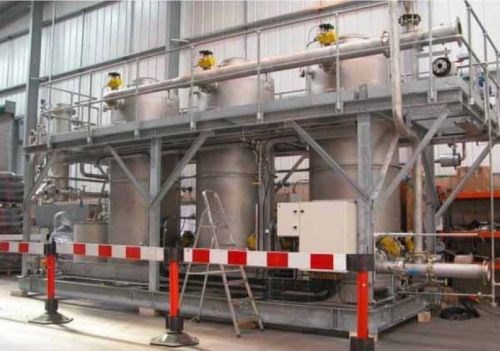
Figure 5 - Three carbon bed adsorber.
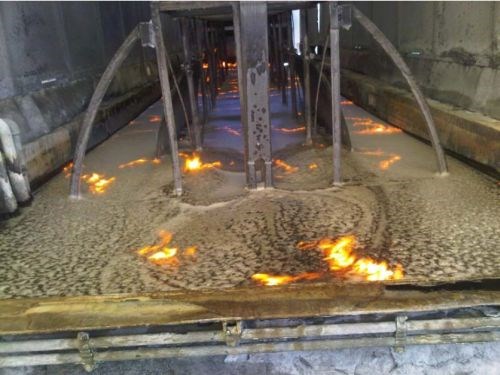
Figure 6 - Hydrogen gas being burned off during the chemical milling process.
RELATED CONTENT
-
Andrews Powder Coating Earns Space Flight Qualification
The first-tier aerospace powder coating supplier recently had its MIL-SPEC powder coatings qualified for coating power supplies for a classified military satellite program.
-
A Protective Decorative Electrolytic Coloring Process for Aluminum
The main task of this work was to study the influence of the different parameters on the electrolytic coloring process for aluminum.
-
Anodizing for Bonding Applications in Aerospace
Anodizing for pre-prep bonding bridges the gap between metallic and composite worlds, as it provides a superior surface in many applications on aluminum components for bonding to these composites.


















